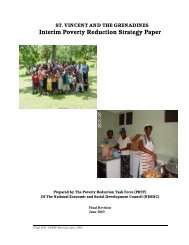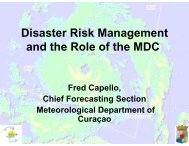The Anatomy of A Silent Crisis The Anatomy of A Silent Crisis
The Anatomy of A Silent Crisis The Anatomy of A Silent Crisis
The Anatomy of A Silent Crisis The Anatomy of A Silent Crisis
- TAGS
- anatomy
- www.bb.undp.org
You also want an ePaper? Increase the reach of your titles
YUMPU automatically turns print PDFs into web optimized ePapers that Google loves.
4 Forum 2009: Climate Change — <strong>The</strong> <strong>Anatomy</strong> <strong>of</strong> a <strong>Silent</strong> <strong>Crisis</strong><br />
<strong>The</strong> time to act is now<br />
Climate change threatens sustainable development and all eight Millennium Development Goals.<br />
<strong>The</strong> international community agreed at the beginning <strong>of</strong> the new millennium to eradicate extreme<br />
hunger and poverty by 2015. Yet, today, climate change is already responsible for forcing some<br />
fifty million additional people to go hungry and driving over ten million additional people into extreme<br />
poverty. Between one-fifth and one-third <strong>of</strong> Official Development Assistance is in climate sensitive<br />
sectors and thereby highly exposed to climate risks.<br />
To avert the worst outcomes <strong>of</strong> climate change, adaptation efforts need to be scaled up by a<br />
factor <strong>of</strong> more than 100 in developing countries. <strong>The</strong> only way to reduce the present human impact<br />
is through adaptation. But funding for adaptation in developing countries is not even one percent <strong>of</strong><br />
what is needed. <strong>The</strong> multilateral funds that have been pledged for climate change adaptation funding<br />
currently amount to under half a billion US dollars.<br />
Despite the lack <strong>of</strong> funding, some cases <strong>of</strong> successful adaptation do provide a glimmer <strong>of</strong> hope.<br />
Bangladesh is one such example. Cyclone Sidr, which struck Bangladesh in 2007, demonstrates<br />
how well adaptation and prevention efforts can pay <strong>of</strong>f. Disaster preparation measures, such as<br />
early warning systems and storm-pro<strong>of</strong> houses, minimized damage and destruction. Cyclone Sidr’s<br />
still considerable death toll <strong>of</strong> 3,400, and economic damages <strong>of</strong> $1.6 billion, nevertheless compare<br />
favourably to the similar scale cyclone Nargis, which hit Myanmar in 2008, resulting in close to<br />
150,000 deaths and economic losses <strong>of</strong> around $4 billion.<br />
Solutions do also exist for reducing greenhouse gas emissions, some even with multiple benefits.<br />
For instance, black carbon from soot, released by staple energy sources in poor communities, is likely<br />
causing as much as 18 percent <strong>of</strong> warming. <strong>The</strong> provision <strong>of</strong> affordable alternative cooking stoves to<br />
the poor can, therefore, have both positive health results, since smoke is eliminated, and an immediate<br />
impact on reducing emissions, since soot only remains in the atmosphere for a few weeks.<br />
Integrating strategies between adaptation, mitigation, development and disaster risk reduction can<br />
and must be mutually reinforcing. Climate change adaptation, mitigation, humanitarian assistance and<br />
development aid underpin each other, but are supported by different sets <strong>of</strong> institutions, knowledge<br />
centres, policy frameworks and funding mechanisms. <strong>The</strong>se policies are essential to combat the<br />
human impact <strong>of</strong> climate change, but their links to one another have received inadequate attention.<br />
A key conclusion <strong>of</strong> this report is that the global society must work together if humanity is to<br />
overcome this shared challenge: nations have to realize their common interest at Copenhagen, acting<br />
decisively with one voice; humanitarian and development actors <strong>of</strong> all kinds have to pool resources,<br />
expertise and efforts in order to deal with the rapidly expanding challenges brought about by climate<br />
change; and in general, people, businesses, and communities everywhere should become engaged<br />
and promote steps to tackle climate change and end the suffering it causes.







